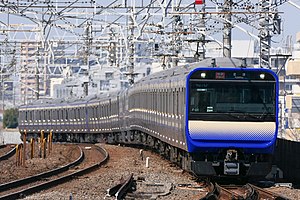This article needs additional citations for verification. (January 2010) |
The Sōbu Line (Rapid) (Japanese: 総武快速線, romanized: Sōbu-kaisoku-sen) is a railway service on the Sōbu Main Line in Tokyo and Chiba Prefecture, Japan, operated by East Japan Railway Company (JR East). It connects Tokyo Station in Chūō, Tokyo with Chiba Station in Chūō-ku, Chiba via the cities of Ichikawa, Funabashi, and Narashino.
| Sōbu Line (Rapid) | |||
|---|---|---|---|
| JO | |||
 An E235 series EMU at Ichikawa Station | |||
| Overview | |||
| Locale | Tokyo, Chiba prefectures | ||
| Termini | |||
| Stations | 10 | ||
| Service | |||
| Type | Commuter rail | ||
| Operator(s) | JR East | ||
| Daily ridership | 693,998 (daily 2015)[1] | ||
| History | |||
| Opened | 1972 | ||
| Technical | |||
| Line length | 60.2 km (37.4 mi) | ||
| Track gauge | 1,067 mm (3 ft 6 in) | ||
| Electrification | 1,500 V DC overhead catenary | ||
| Operating speed | 120 km/h (75 mph) | ||
| |||
Services
editRapid services on the Sōbu Line are primarily operated between Tokyo and Chiba, although there are many through services onto the Yokosuka Line as well as some through services operated from the Yokosuka Line via Tokyo terminating at Tsudanuma. During weekday morning peak periods Tokyo-bound trains arrive once every 3.2 minutes; this is reduced to 10 Chiba-bound trains per hour during weekday evening peak periods. At other times there are approximately six trains per hour. There are many through services operated onto other lines.
For information on the Narita Express, Shiosai, and other limited express services, see their respective articles.
Sōbu Line (Rapid) trains travel through onto the Yokosuka Line to Ōfuna, Zushi, and Kurihama. Trains also travel through beyond Chiba to as far as:
- Kazusa-Ichinomiya on the Sotobō Line
- Kimitsu on the Uchibō Line
- Narita Airport via Narita on the Narita Line
- Kashima-Jingū on the Kashima Line
- Narutō on the Sōbu Main Line
Past services
editHome Liner Chiba
editBefore 16 March 2019, there were five Home Liner Chiba commuter liner services that operated every weekday evening, four of which started from Tokyo and another which started at Shinjuku.
Stations served:
(Shinjuku – Akihabara) / Tokyo – Tsudanuma – Inage – Chiba
Limited Express Ayame
editCommuter Rapid
editCommuter Rapid services were abolished with the timetable revision on 12 March 2022.[2] Prior to this they ran on weekday peak hours only, stopping at Tōkyō, Shin-Nihombashi, Bakurochō, Kinshichō, Funabashi, and Chiba.
Station list
edit- For information on local services between Kinshichō and Chiba, see the Chūō-Sōbu Line article.
- All rapid trains stop at all stations listed below.
Note: Special Rapid service was discontinued on 4 March 2017.[3]
Rolling stock
editRapid service
edit- E217 series (from December 1994)
- E235-1000 series (from 21 December 2020)[4]
Limited express service
edit- 255 series (Shiosai)
- E257 series (Shiosai)
- E259 series (Narita Express)
Former rolling stock
edit- 113 series (from October 1980 to December 1999)
History
editOn 20 August 2016, station numbering was introduced with stations being assigned station numbers between JO19 and JO28.[5][6] Numbers increase towards in the eastbound direction towards Chiba.
References
edit- ^ "平成27年 大都市交通センサス 首都圏報告書" (PDF). P.92. 国土交通省.
- ^ "JR East March 2022 Timetable Revision" (PDF). JR East (in Japanese). Retrieved 12 January 2024.
- ^ 2017年3月ダイヤ改正について [Timetable revision in March 2017] (PDF) (in Japanese). Japan: East Japan Railway Company. Retrieved 18 January 2017.
- ^ "⾸都圏エリアへ 「駅ナンバリング」を導⼊します" [Introduce “station numbering” to the Tokyo metropolitan area] (PDF). jreast.co.jp (in Japanese). 6 April 2016. Archived from the original (PDF) on 7 December 2022. Retrieved 7 January 2023.
- ^ Kusamachi, Yoshikazu (7 April 2016). "JA・JK・JT・AKB…JR東日本、首都圏で駅ナンバリングなど導入へ" [JA, JK, JT, AKB … JR East to introduce station numbering in the Tokyo metropolitan area]. Response Automotive Media (in Japanese). Archived from the original on 6 August 2022. Retrieved 7 January 2023.
External links
edit- Stations of the Sōbu Line (Rapid) (unofficial) (in Japanese)
